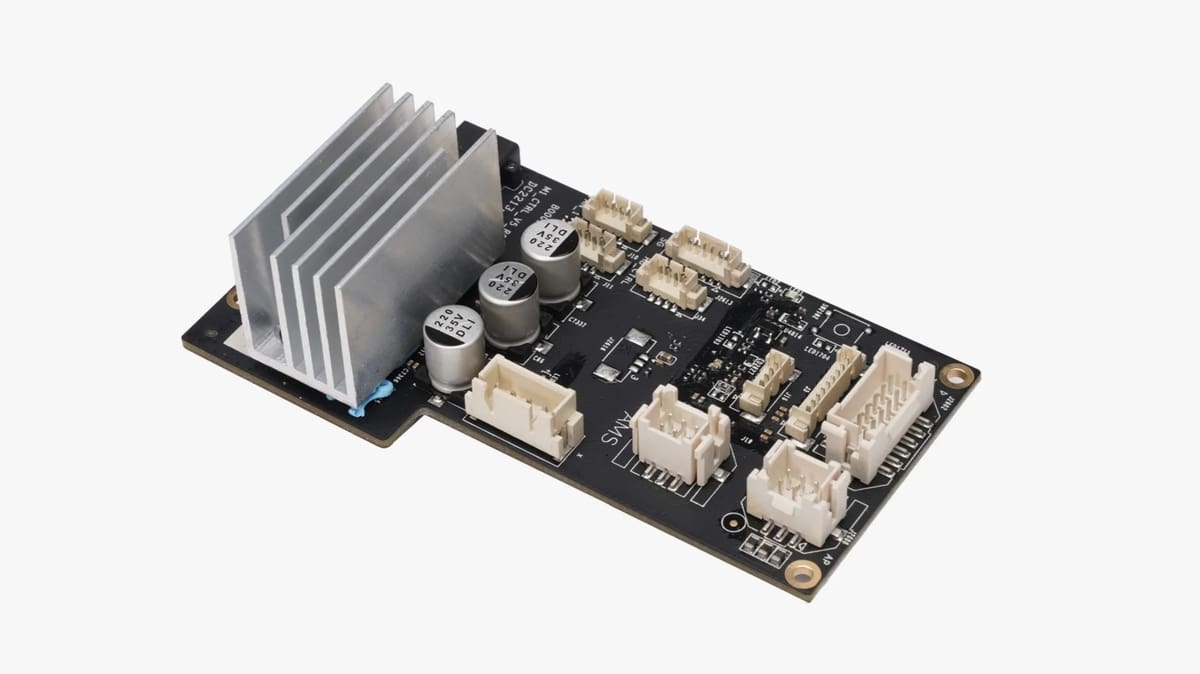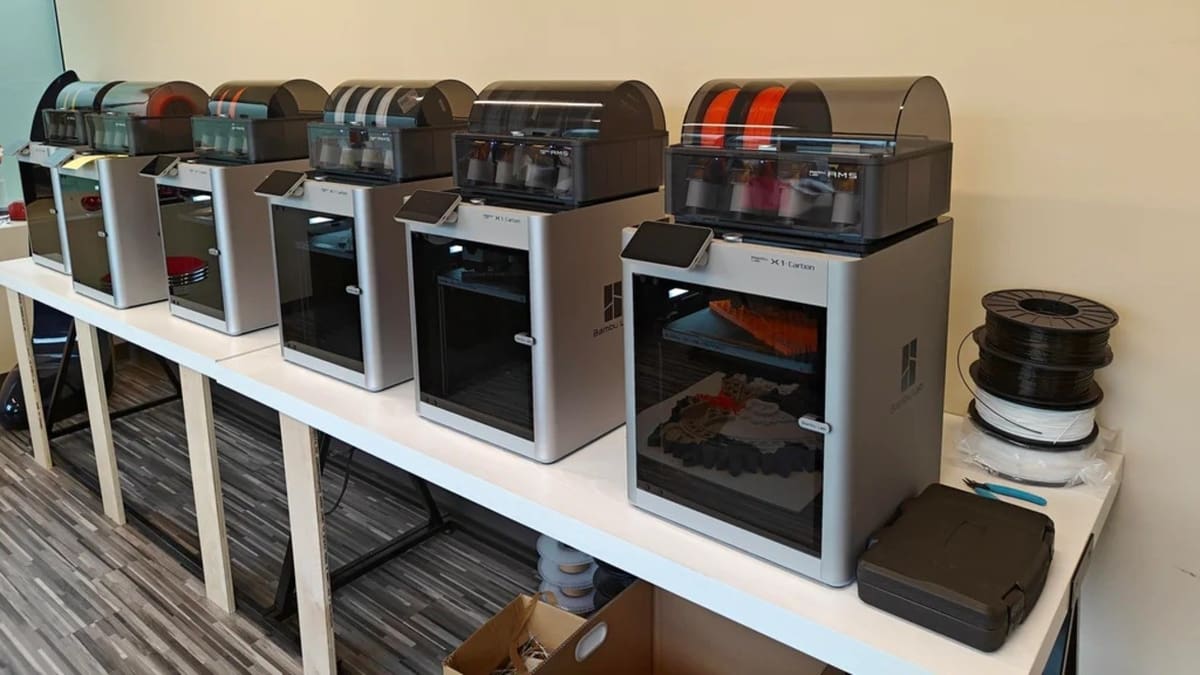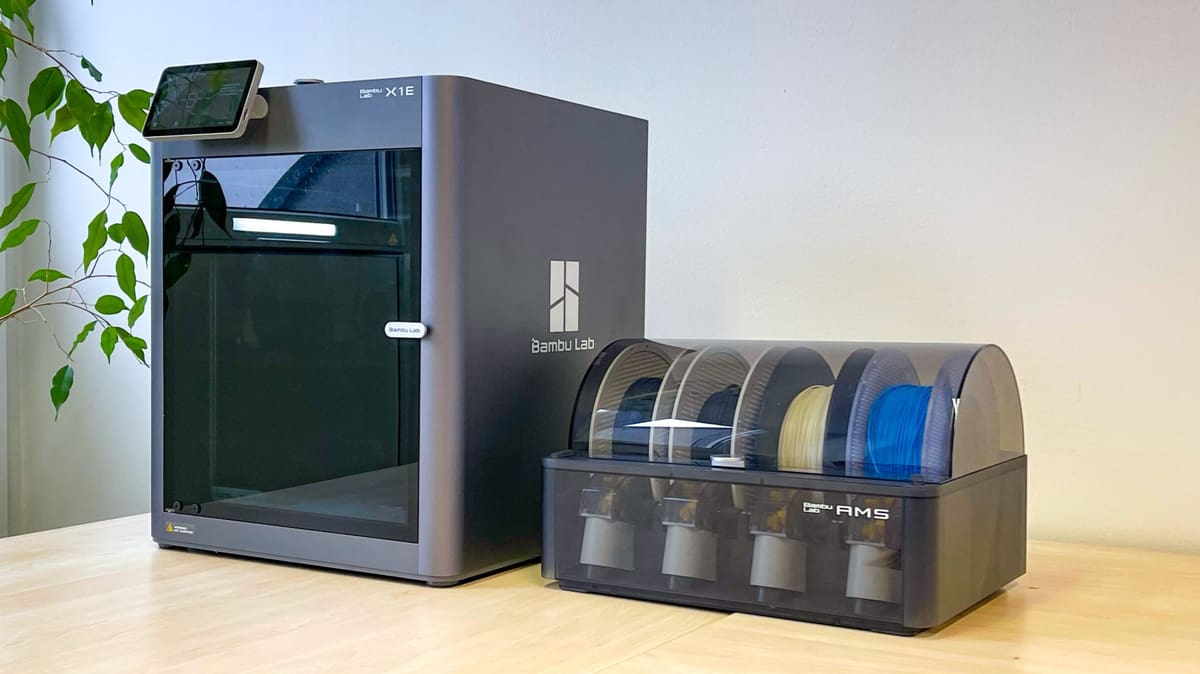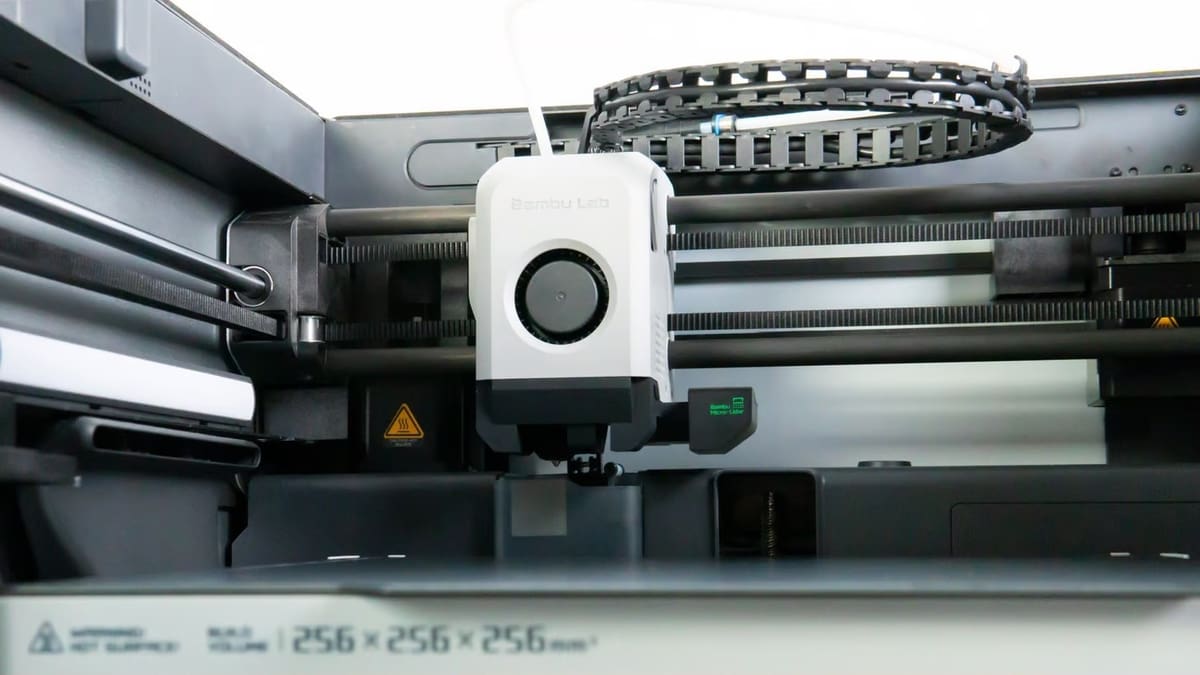When the Bambu Lab X1 Carbon (X1C) came out in 2022, it disrupted the consumer 3D printing industry with its high printing speed, extreme reliability, and tinker-free operations. It quickly became the go-to option for many hobbyists.
Around the end of 2023, Bambu Lab launched the X1E, which wasn’t aimed at regular consumers. Instead, it was meant for professional users such as engineering firms and R&D departments. They addressed some of the well-known security concerns of X1C and made the X1E more enterprise-friendly overall with an impressive number of network security features.
But if you’re a regular consumer or a business owner, which one would be the right fit for you? That’s what we’ll be discussing today!
In this article, we’ll be going over the core differences between the X1C and X1E in terms of security features, design upgrades, and price. By the end of the article, you should have a pretty good idea of the unique value proposition of both printers and understand how they are different.
Without further ado, let’s get started!
At a Glance
Design

When choosing a printer, build volume might be one of your key deciding factors. If it’s too small, printing many small models at the same time or one too big one might be off the table. If it’s too big, heating up things might take longer, even if you want to print something small.
Fortunately, Bambu Lab hits the sweet spot with the build dimensions.
Build Volume
Both the X1E and the X1C have the same build volume of 256 x 256 x 256 mm, out of which 18 x 28 mm at the front left part is blocked off to make room for some accessories. It’s possible to make a minor modification to unlock the entire build volume. However, in that case, you won’t be able to use AMS (which we’ll get to further below).
The build volume is still larger than most of the printers in the same segment (usually 220 x 220 x 250 mm), and is enough for most useful or decorative models you might be printing. Another advantage of the medium-sized build volume is that it doesn’t take long to heat up.
Build Plate
As for the build plate, both printers come with a flexible and removable magnetic one that’s fairly standard these days for ease of print removal. However, the surfaces aren’t the same.
The X1C ships with either the textured PEI sheet or the Bambu Engineering plate, which is basically a double-sided build plate claimed to be stronger than PC or PEI-coated beds. Both are excellent; the textured PEI sheet gives the bottom surface of your print a shiny, flaky finish, while the Engineering plate offers better support for printing engineering materials.
The X1E ships with a smooth PEI sheet that allows your first layer to be silky smooth. However, this is a rather odd choice as a smooth sheet isn’t necessarily the best option for printing trickier materials like ABS or even PETG, because you benefit from using glue (which can get messy) to avoid damaging the bed. While this PEI sheet is arguably more suitable for PLA, it might not make much sense for a printer that’s meant to be used for high-temperature materials to ship with a smooth PEI sheet – textured PEI would probably be more appreciated by its target users.
In any case, buying a textured PEI sheet (or a smooth one, if you’re opting for the X1C, or any other build plate) only costs a small fraction of the printer’s total price, so this isn’t necessarily a dealbreaker. Just keep in mind the size.
Both printers have a max bed temperature of 110 °C, which is sufficient for all the materials the extruders support.
Extrusion
This is where the X1E stands out. Although both the X1E and X1C have a direct extrusion setup with an all-metal extruder with a hardened steel nozzle, the X1E’s nozzle temperature can get up to 320 °C, while the X1C can only go up to 300 °C.
The 20 °C difference may not sound like much, but it opens up an entirely new set of possibilities when it comes to printing high-temperature engineering filament.
The X1C can’t print exotic materials such as carbon or glass-fiber-filled PPA (polyphthalamide) or PPS (polyphenylene sulfide) because they require a higher nozzle temperature than 300 °C. However, the X1E can print both of these materials.
Chamber Heater
In addition to the more powerful hot end, the X1E also comes with a built-in chamber heater that allows it to heat the build chamber up to 60 °C. It’s very useful to prevent print failures from warping while printing high-temperature materials such as nylon (PA), PC, ABS, or ASA. It also makes the prints more consistent overall as you can control the temperature inside the chamber from the 5-inch display.
While the X1C doesn’t have an active chamber heater, since it’s also enclosed, it’s possible to heat the chamber of X1C by leaving the bed hot for some time. But this is time-consuming and inefficient in terms of power consumption, plus there’s no way to control the chamber temperature reliably.
Under the Hood

The electronics of the X1 series are pretty well-designed and work well. Let’s take a closer look.
Mainboard
Both models come with a proprietary Bambu Lab controller board; there are no differences in performance or specifications. It’s a 32-bit board equipped with an SPC2168 microcontroller and AT8236 stepper motor drivers. The drivers can easily keep up with the high-speed printing, although the noise level is somewhat higher than other machines (that said, it’s not disruptive).
However, the X1E also comes with a Network Interface Board connected to it, which provides some critical security features aimed at companies. This is important because people have had security concerns about X1C’s cloud connectivity, which Bambu Lab has addressed publicly.
Even though you can technically turn the cloud off and run it locally, there’s no way to physically remove the Wi-Fi module from the controller board, so the chance of having a network breach is always there. That, along with the lack of an Ethernet port, makes it a hard pass for the larger firms that handle sensitive information on a regular basis.
With the X1E, Bambu Lab has solved the issues by adding the Network Interface that offers an Ethernet port, a Network Kill Switch (for both Wi-Fi and Ethernet), a removable Wi-Fi module, 802.1X Enterprise-grade Network Access Control, and WPA-Enterprise support. It also has support for EAP-PEAP, EAP-TLS, and TAP-TTLS network access authentication to allow encrypted communication between the user and the printer. Lastly, the X1E doesn’t require connecting to Bambu Lab’s cloud servers at all and can run totally off the grid.
It does come with a small caveat though – you still need to connect to the cloud using a mobile app in order to update the firmware. Nonetheless, the Enterprise-grade networking features are still a great addition to the X1E.
Firmware
Speaking of firmware, the X1 series doesn’t run Marlin or Klipper-based firmware commonly found in other printers. Instead, it runs a proprietary Linux-based firmware developed by Bambu Lab.
There are no major differences between the firmware of X1 Carbon and X1E. Both printers are well-capable of hitting 500 mm/s in max speed and 20,000 mm/s² in acceleration. In addition to that, the X1E’s firmware includes support for the aforementioned Enterprise-grade networking hardware.
Quality of Life Features

As we would expect from Bambu Lab, the X1C and the X1E are packed with plenty of QoL (Quality of Life) features. These technically don’t help with print quality, but they will make your life much easier, for example automating painstaking tasks like bed leveling.
Bed Levelling & AI-Based Failure Detection System
In today’s market, even most entry-level printers are equipped with automatic bed leveling. However, although they’re called automatic, the user might still have to set the Z offset (the distance between the nozzle and the bed), which can be pretty confusing for newcomers. Not to mention, it needs to be recalibrated from time to time.
Fortunately, the X1C and X1E come with fully automated bed leveling, where the nozzle repeatedly taps three points on the bed and sets the Z offset by itself with the help of load cell sensors. No user intervention is required at all. Along with that, there’s also a state-of-the-art lidar sensor that scans the bed, checking for any sort of issue as the first layer prints. If the AI detects any risk of failure in the first layer, it will prompt the user to check the print and decide whether they would like to continue or stop the print.
The bed comes trammed properly from factory. In case you need to make any further adjustments, there are three screws underneath the bed that can be used to do manual tramming.
UI
The X1C and X1E boast the same display, a large 5-inch (1,200 x 720 pixel) full-color LCD touchscreen. It has a pretty responsive user interface with a snappy touch response, allowing you to operate the printer easily. Controlling functions like heating (and chamber temperature for X1E), starting, pausing, stopping prints, and loading and unloading filament can be done from the screen. Moreover, for the X1E, the additional networking hardware can also be configured from the menu.
Most users prefer controlling the printer remotely through Bambu Studio (which we’ll look at below) as you don’t have to get up from the computer. Having said that, a display onboard is always handy.
Software
Bambu Lab has its own open-source slicer called Bambu Studio, which should be used for the X1C and X1E for best user experience. Some users have successfully used Cura too, but it’s not something officially supported and there are no Bambu Lab default profiles, so you’ll have to add them yourself.
Bambu Studio is a fork of PrusaSlicer, so the interface is very straightforward and user-friendly. It also borrows a couple of advanced features from other slicers, such as SuperSlicer’s adjustable dynamic print speed and more advanced cooling configuration. Bambu Studio can also perform input shaping and linear pressure advance tuning automatically with the sensors installed on the printer. Prints can be monitored with the live streaming feed from your printer’s camera (1080p).
Bambu Studio’s slicer part is open source, but its cloud connectivity and Bambu Lab encrypted data link are closed source for security reasons. You can control pretty much everything on your printer remotely, as long as both your device (the computer) and the printer are connected to the same network.
If you want to check up on your prints or control your printer remotely when you’re not at home, there’s also the Bambu Handy mobile app that allows you to access your printer from anywhere.
Additional Features

Finally, the X1 series offers some functionalities that extend beyond printing. Here’s what you need to know:
Air Purification
Some high-temperature materials like ABS can release an unpleasant odor or fumes as they print. Since both printers are enclosed, the smell isn’t that big of a deal. That being said, having some sort of air filtration system is always useful.
The X1C comes with an activated carbon filter that uses coal-based pellets and is capable of performing VOC (volatile organic compounds) filtration. On the other hand, the X1E takes the crown with its G3 grade pre-filter, H12 grade HEPA filter, and particulate matter filtration. Additionally, it also boasts a granulated coconut shell-based activated carbon filter, which is better than the X1C’s coal-based carbon filter.
You can upgrade the X1C’s existing air purification system with community mods like the BentoBox, which is also used in Voron printers, although this will require a bit more tinkering than you might be aiming for.
Support for AMS (Automatic Material System)
Needless to say, both the X1C and X1E fully support the Automatic Material System (AMS) – the multi-material printing system developed by Bambu Lab. A single AMS unit can house up to four spools, allowing you to use up to four different materials or colors of the same material in your print. With the help of an AMS hub, you can use up to 4 AMS modules together – or 16 colors or materials in total.
One thing to note is that some fiber-infused materials (like carbon fiber filaments) won’t work well with the AMS as they might snap or get tangled up in the system – same goes for flexible filaments like TPU or TPE (and watch out for cardboard spools).
Price

The X1C is priced at ~$1,200 (~$1,450 with the AMS), and the X1E is priced at ~$2,500 (including the AMS), although you might be able to get it X1E without an AMS depending on the reseller.
It might seem a little odd for the X1E to be sold at essentially double the price (even with the AMS included), especially when, as far as printing performance goes, neither offers a drastic improvement over the other, but there is some logic behind it.
Apart from the better air filtration system and the upgraded chamber and nozzle heating, the major difference between the X1C and X1E is the latter’s enterprise-grade networking capability. Most hobbyists who will be using the printer at home will more than likely not need such a setup.
However, the machine isn’t all that’s included in the price of the X1E. Makers can buy the X1C directly from Bambu Lab, but the X1E is sold exclusively through resellers. This is because larger companies might be looking for enterprise-level technical support while buying equipment – something that Bambu Lab doesn’t offer at the moment.
All in all, the X1C and the X1E are priced fairly for what they have to offer and their respective target audiences: consumers and enterprises. The X1C might be a bit more expensive than other hobbyist printers, but it offers a lot of value for its price. The X1E, while more costly, offers more relevant value for enterprises, catering specifically to their needs.
Verdict

Now that we have discussed the differences and the value proposition of each printer, let’s take a quick moment to recap everything.
The X1 Carbon is designed to be a reliable and sophisticated 3D printer that just works without any tinkering. It does lack a dedicated chamber heater and the nozzle temperature maxes out at 300 °C, but it’s still great for printing hobby-grade filaments like PLA and PETG and even entry-level engineering materials like ABS, ASA, and nylon. The after-sales support is provided by Bambu Lab themselves.
The X1E offers everything the X1C does. But on top of that, it also offers more options for printing engineering materials (better stock air filtration performance included), as well as something very important for security-conscious enterprises: compatibility with enterprise-grade networks and being able to run off the grid from an Ethernet port. As for after-sales support, it’s provided by the reseller it was purchased from.
While it’s an excellent machine, the X1E isn’t really meant for hobbyists. If you really need a high-temperature hot end and active chamber heating, there are other options in the market, such as the Qidi Tech X-Plus 3, which are on par with Bambu Lab in terms of reliability. Moreover, it also offers an Ethernet connection if you have concerns with X1C’s cloud connectivity.
That said, if you have a company that’s looking for a reliable printer and are worried about the security risks of X1C, the X1E can cater to your needs. Not only does it address and mitigate all the security shortcomings of X1C, but you’ll also get proper enterprise-grade support from the reseller on top of the existing reliability of X1 Carbon.
Happy shopping!
License: The text of "Bambu Lab X1E vs X1C: The Differences" by All3DP is licensed under a Creative Commons Attribution 4.0 International License.
CERTAIN CONTENT THAT APPEARS ON THIS SITE COMES FROM AMAZON. THIS CONTENT IS PROVIDED ‘AS IS’ AND IS SUBJECT TO CHANGE OR REMOVAL AT ANY TIME.






